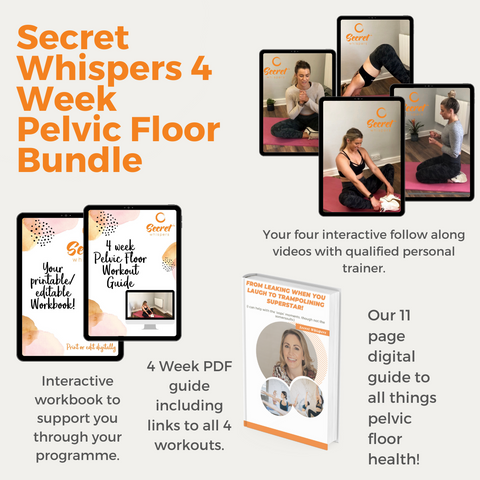Can a Pelvic Organ Prolapse Go Away on Its Own?

In mild cases, a pelvic organ prolapse might go away on its own. However, it could also get worse over time. This is why it is best to seek medical advice as soon as possible. Ask to be seen by a pelvic floor physiotherapist. If you would like to find one in your area you can find them via The Pelvic, Obstetric and Gynaecological Physiotherapy.
Pelvic organ prolapse is a condition that many women find themselves struggling with. The uncertainty surrounding how it happened, can be both puzzling and concerning. For some, the fear of 'something dropping out' can cause huge anxiety issues.
In some instances, particularly in mild cases, there is a possibility that a pelvic organ prolapse may resolve on its own. However, it's crucial to understand that this outcome is not guaranteed, and the condition might also worsen over time. So, please don't ignore.
What Treatment Options Are Available for a Prolapse?
Treatment #1: Pelvic Floor Exercises

One of the most common and effective treatments for pelvic organ prolapse is a regimen of targeted pelvic floor exercises, known as Kegels. These exercises aim to strengthen the muscles supporting the pelvic organs, providing them with better support and stability.
Type: Non-surgical
Cost: Minimal to none
Ease of Implementation: Simple and can be done at home
Engaging in a regular pelvic floor exercise routine can yield positive results. This treatment option is accessible and cost-effective, making it an attractive choice for many women.
It's relatively straightforward to perform, and by using Secret Whispers' Pelvic Floor Toner they maximum the benefits of Kegels by strengthening your muscles and also teach you where your actual pelvic floor muscles are.
Using our Secret Whispers Kegel Weights will teach you where your correct pelvic floor muscles are and will help to strengthen your pelvic floor muscles from just 15 mins a day. Check out the reviews here. You will wish you had bought them sooner!
Additionally, Secret Whispers offers a 4-week Pelvic Floor Workout Programme for those seeking structured guidance or if you would like to be part of our next 30 Day Pelvic Floor Challenge, that starts in January 2024, where you are in a live closed group for support and accountability.
Treatment #2: Lifestyle Changes
Incorporating certain lifestyle modifications can also play a crucial role in managing pelvic organ prolapse. Maintaining a healthy body weight, avoiding heavy lifting, using the 'Knack' technique when lifting, and practicing good bowel habits can help alleviate strain on the pelvic floor.
Type: Non-surgical
Cost: Minimal to none
Ease of Implementation: Requires commitment and habit adjustments
Simple yet impactful, lifestyle changes, can all complement other treatment methods. They provide a holistic approach to managing pelvic organ prolapse and can contribute significantly to improved quality of life.
Treatment #3: Hormone (Oestrogen) Treatment

The decline in estrogen levels additionally contributes to a reduction in thickness and strength of the pelvic floor muscles. This can potentially result in a pelvic organ prolapse.
If you're in the perimenopausal phase, the initial sign of a possible prolapse may manifest when you notice slight urine leakage during activities like exercising, laughing, coughing, or sneezing.
Your physician might suggest oestrogen treatment to alleviate this and specific symptoms like vaginal dryness or discomfort during intercourse.
Oestrogen can be administered in various forms:
- Topical cream for vaginal application
- Vaginal tablet insertion
- Oestrogen-releasing vaginal ring.
Treatment #4: Pessary Insertion
A pessary is a removable device that is inserted into the vagina to support the prolapsed organs. It works by providing structural support to the pelvic floor, alleviating symptoms and potentially allowing the prolapse to regress.
Type: Non-surgical
Cost: Varies, typically covered by insurance
Ease of Implementation: Some requires professional fitting and others you can be taught how to remove and insert for yourself.
A pessary can be a highly effective option for women seeking non-surgical intervention. It's a versatile solution that can be tailored to individual needs. While it requires professional fitting at first, once in place, it can significantly improve the quality of life for those affected by a pelvic organ prolapse.
Treatment #5: Surgical Intervention
For more severe cases of pelvic organ prolapse, surgical intervention may be recommended. There are various surgical procedures available, ranging from minimally invasive techniques to more extensive reconstructive surgeries, including closing the vagina.
Type: Surgical
Cost: Covered by insurance in most cases
Ease of Implementation: Requires hospitalization and recovery period
Surgery is typically reserved for cases where conservative measures have not provided sufficient relief. While it involves a hospital stay and recovery period, it can be highly effective in some cases addressing the prolapse and improving quality of life.
CLOSING THOUGHTS
In conclusion, while a mild pelvic organ prolapse may potentially resolve on its own, it is not a guaranteed outcome. Seeking appropriate treatment is crucial to managing this condition effectively. Pelvic floor exercises, pessary insertion, and surgical intervention are viable options, each with its own merits.
Consulting with a healthcare provider and undergoing pelvic floor physio treatments prior to any surgery being considered is essential to determine the most suitable approach for your specific situation.
For additional insights on pelvic health and exercises, be sure to explore Secret Whispers' comprehensive resources:
- The Ultimate Guide to Pelvic Prolapse and Exercise
- The Purpose of Pelvic Floor Exercises
- Is It Too Late to Start Pelvic Floor Exercises?
- How Long Does It Take to Tighten Pelvic Floor Muscles?
Secret Whispers 4-Week Pelvic Floor Workout Programme
SECRET WHISPERS 30-DAY PELVIC FLOOR CHALLENGE
In this challenge you will learn how to do your Kegel exercises correctly and incorporate them into every day daily activities. Check out all of the reviews
For any inquiries or further assistance, don't hesitate to contact us. Take charge of your pelvic health journey today!
Never miss another blog again. Sign up now to our weekly Newsletter. You will get a 10% discount code to use too. Just click below ⬇️⬇️⬇️














